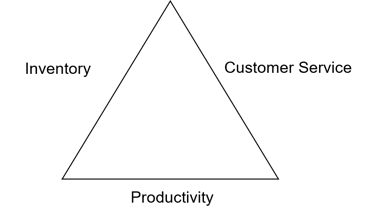In our last post, we discussed the concept of the triad, a model used to show us the basic objectives of the manufacturing control system and its relationship to Customer Service. In this second post, we'll dive into the next components: Inventory and Productivity.
Inventory

APICS defines Inventory as:
“1) Those stocks of items used to support production (raw materials and work in process items) supporting activities (maintenance, repair and operating supplies), and customer service (finished goods and spare parts) …”
 |
Generally, the lower the inventory, the better it is for the stocking organization. Most businesses try to keep inventory levels low because it is more cost effective. One of the basic financial ratios is the level of inventory to sales level stated as the cost of goods sold (e.g., Inventory Turns ratio). The more sales you can produce with less inventory the better financially. Or to put it another way, organizations that ship more with less are financially better than those who don’t. |
There are various methods to reduce the investment in inventory. These include:
- Increasing flexibility from capacity, not inventory (i.e., move from a make-to-stock to an assemble-to-order manufacturing strategy).
- Decreasing costs in the beginning stages of the process by matching the timing of demand and supply. When purchased goods are brought in or manufactured items produced too soon, inventory increases.
- Increasing how much space is available for manufacturing. By reducing inventory, more room may be freed for production. Lean Manufacturing implementations often report that an enormous amount of free space is created.
Since decreasing on-hand inventory could negatively affect Customer Service, it would be beneficial to review inventory needs, then adjust inventory levels accordingly. How much to carry and where (i.e., finished goods, work in process or raw material) is therefore a critical decision. Aggregate inventory analysis, ABC analysis and surplus and obsolescence analysis are methods of managing inventory. The overall value of Inventory should be minimized.
Productivity

Productivity is making effective use of resources by maximizing the output of a given set of inputs. It’s a capacity narrative where productivity equals utilization times efficiency. Utilization is how well a resource is managed and is a measurement of management. Efficiency is how well the resource performs around a standard or expectation and is a measure of the resource. Productivity should be maximized, but the theory of constraints tells us it’s impossible to maximize all resources.* Let’s look at those in more detail.
Efficiency
Efficiency is how well an employee can perform against a standard – the ratio of actual hours vs. standard hours. When reporting direct labor, each person will perform differently compared to the standard. If your efficiency is greater than one, then you are beating the standard. Less than one indicates you are slower than the standard.
The APICS definition of efficiency is:
“A measurement (usually expressed as a percentage) of the actual output to the standard output expected. Efficiency measures how well something is performing relative to existing standards; in contrast, productivity measures output relative to specific input, e.g., tons/labor hours. Efficiency is the ratio of (1) actual units produced to the standard rate of production expected in a time period or (2) standard hours produced to actual hours worked (taking longer means less efficiency) or (3) actual dollar volume of output to a standard dollar volume in a time period.”
“A measurement (usually expressed as a percentage) of the actual output to the standard output expected. Efficiency measures how well something is performing relative to existing standards; in contrast, productivity measures output relative to specific input, e.g., tons/labor hours. Efficiency is the ratio of (1) actual units produced to the standard rate of production expected in a time period or (2) standard hours produced to actual hours worked (taking longer means less efficiency) or (3) actual dollar volume of output to a standard dollar volume in a time period.”
Utilization
Utilization is how well you can perform with regard to the total time that you have available. It is the ratio of the number of hours worked against the number paid for. It indicates how well managed you are. A way to understand utilization is that you cannot be productive if you have no work. If you are utilized less than 1, then you have time available, but no work. If your utilization factor is 1, then you have in essence worked every possible minute.
The APICS definition of utilization is:
“A measure (usually expressed as a percentage) of how intensively a resource is being used to produce a good or service. Utilization compares actual time used to available time. Traditionally, utilization is the ratio of direct time charged (run time plus setup time) to the clock time available. Utilization is a percentage between 0% and 100% that is 100% minus the time lost due to machine, tool, worker, etc. unavailability.”
Notice that both Efficiency and Utilization are measures around a standard. In a standard cost system, standards are created before production starts. You can, therefore, appreciate how accurate standards are important to measuring capacity. What may not be clear is that the above two measures are used to gauge your standards. How bogus your standards are will show up in these measures.
The APICS definition of productivity is:
“The overall measure of the ability to produce a good or a service. It is the actual output of production compared to the actual input of resources. Productivity is a relative measure across time or against common entities (labor, capital, etc.).”
 |
To be productive, you must utilize your assets close to 100% of the time, and each of your assets must meet or exceed the defined standard. When you exceed in both areas, Productivity jumps. Operationally, this makes perfect sense. We design production practices and train our staff so that they can perform to the standard (or better). As managers, we keep them working as much as we can, but only on items that are required. The better we do this, the more we can accomplish with the level of resources we have. This in essence is what Operations Management is all about. |
Generally, the higher the Productivity, the better it is for the production organization. Most businesses set a goal to maximize Productivity levels because it decreases costs for them. There are various methods to increase Productivity. These include:
- Setting better labor standards. Efficiency is performance around a standard.
- Training people in standard work methods. There is typically a better way to do something.
- Utilizing people’s time better. Minimize non-productive periods.
- Profit through cost reduction (by eliminating waste and reducing overhead).
- Build to demand (better use of the labor pool, labor applied to current period cost of goods sold).
- Increasing quality (lot size reduction).
- Decreasing cycle time.
Part of productivity management is setting accurate standards and then having a trained workforce that can meet and beat those standards. Too much efficiency in the production function may cause transactions to be missed, which compromises the Inventory objective. Do you keep production running at the cost of inventory? Let us know in the comments below! We'll dive into the next components, including Cost, and Quality and Accuracy, in the next post. Make sure you subscribe to our blog for the latest updates. You can also check out the recorded webinar from "Solving Department Issues Using the Triad"
Thank you for perusing our series on Solving Department Issues Using the Triad! If you'd like to skip around and reference the various parts of the series, you can find them all here.
- Introduction
- Customer Service
- Inventory and Productivity
- Cost and Quality and Accuracy
- Watch the recorded webinar
*Three predominant manufacturing philosophies fall within this discussion including ERP, Theory of Constraints and Lean Manufacturing. Lately, the term Supply Chain Management is also used to discuss how levels of the MCS link together. Each of these areas has its own focus and benefits. All are highly related. It is this author’s opinion that the best from all of these areas may be used together in any one system. Other consultants may not support that idea.






